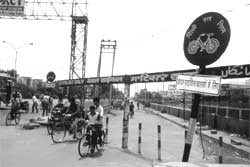Hindustan motors
 Whereas European cities are making an effort to return to walking and cycling through innovative ways of pedestrianisation and car-restraint policies, the tradition of cycling and walking is being squeezed out of Asian cities. Only Japan and Singapore are making some efforts to revive these practices. In Chinese cities, where non-motorised transportation can still cover up to 80 per cent of total daily trips, wrong transportation policies are edging them out. This policy neglect is most obvious in Indian cities that are now in the deadly grip of killer fumes and noise. Since non-motorised modes are seen as a symbol of backwardness, infrastructure development is planned only for cars and other motorised transport. This is leading to fast deterioration of road conditions for cyclists and pedestrians. Roads are more dangerous for them and not enough space is left to accommodate them.
Whereas European cities are making an effort to return to walking and cycling through innovative ways of pedestrianisation and car-restraint policies, the tradition of cycling and walking is being squeezed out of Asian cities. Only Japan and Singapore are making some efforts to revive these practices. In Chinese cities, where non-motorised transportation can still cover up to 80 per cent of total daily trips, wrong transportation policies are edging them out. This policy neglect is most obvious in Indian cities that are now in the deadly grip of killer fumes and noise. Since non-motorised modes are seen as a symbol of backwardness, infrastructure development is planned only for cars and other motorised transport. This is leading to fast deterioration of road conditions for cyclists and pedestrians. Roads are more dangerous for them and not enough space is left to accommodate them.
Delhi, the capital city, is an excellent example of mindless traffic planning. Apart from feeble gestures to get a plan for bicycle tracks or pedestrianise a few shopping malls in Delhi, nothing much has really happened. Only after the Supreme Court ( sc ) began to mount pressure on the Delhi government to take action to control vehicular pollution, the Union Ministry of Environment and Forests issued a White paper on the state of Delhi's pollution in December 1997. The White paper proposed for the first time a "provision for bicycle tracks and greater use of existing tracks' and the responsibility was assigned to the traffic police department to implement it by April 1, 1999. The Environment Pollution Control and Prevention Authority ( epcpa ) responsible for monitoring of the sc orders found no action was taken on this count.
All proposals for exclusive bicycle paths are buried in files. Transportation Research and Injury Prevention Programme ( tripp) , spearheaded by a team of transportation planners and engineers in Indian Institute Technology, Delhi, has prepared a bicycle master plan for Delhi. This master plan, submitted to the Delhi government, brings out detailed design solutions for the existing roads to improve flow of all modes of transport including the non-motorised mode. But action is missing in this direction too.
Yet there is an immense potential to create car-free zones in Delhi. When members of the Central Road Research Institute in Delhi surveyed the traffic pattern in Delhi in 1990, they were amazed to note that bicycle usage in many parts of Delhi was still very high. It was as high as 48 per cent of the total traffic flow in gt Shahadra road in east Delhi, 45 per cent on Madangir road in South Delhi, 45 per cent in Loni road in east Delhi and so on (see box: The josh machines ).
The proportion of bicycle traffic is more than 30 per cent of total traffic during peak hours on many arterial roads. On one of the major highways (Rohtak Road), cycles constitute 43 per cent of the total traffic during peak hours. Even today, Geetam Tiwari of tripp estimates that 25 per cent of shopping trips, 15 per cent of the trips to work, and 50 per cent of the trips to schools can be undertaken by bicycles. Though the share of bicycle trips has declined over the years, it is not certain whether the absolute number of bicyclists have reduced. A large number of commuters still cycle or walk along the inter-city highways with comparatively long trip length
Related Content
- Order of the High Court of Rajasthan regarding installation of a petrol pump near a crematorium and high-tension line, 05/03/2025
- Order of the National Green Tribunal regarding illegal filling of wetland, Hoogly, West Bengal, 16/09/2019
- Over 40 Indian firms make carbon disclosures
- Order of the National Green Tribunal regarding the status of wetland/water bodies within the 314 acres of land of Hindustan Motors, West Bengal, 05/01/2017
- ACC, Wipro, Reliance among India’s most sustainable companies: survey
- Report of high powered committee on how to decongest Delhi
